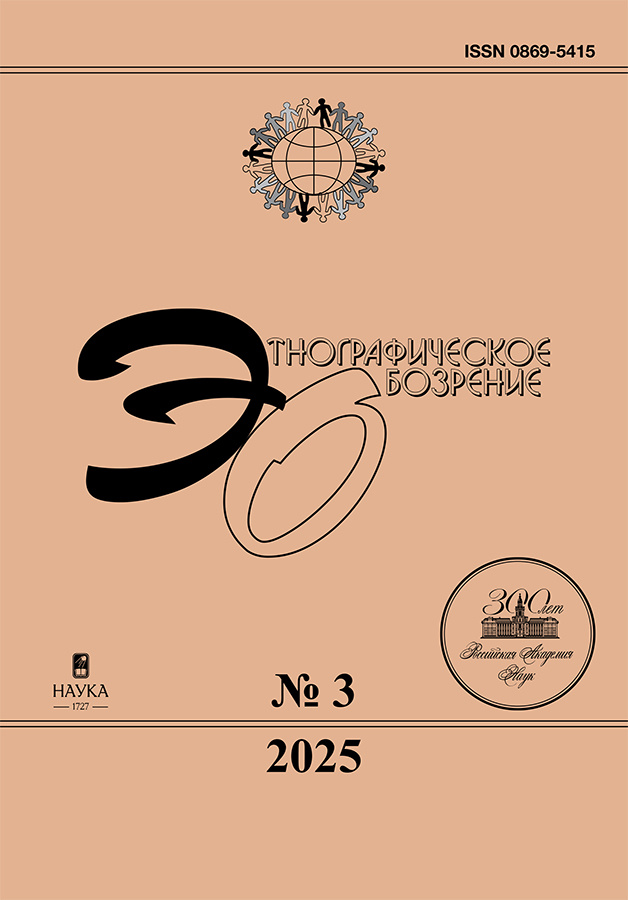Lived religion of the devotees of rural surbs in Armenia
- Authors: Kryukova N.V.1
-
Affiliations:
- Institute of Ethnology and Anthropology, Russian Academy of Sciences
- Issue: No 1 (2024)
- Pages: 77-92
- Section: Folk Christianity in Armenia
- URL: https://ruspoj.com/0869-5415/article/view/672578
- DOI: https://doi.org/10.31857/S0869541524010041
- EDN: https://elibrary.ru/YHBSLL
- ID: 672578
Cite item
Abstract
The article analyses the beliefs and practices of rural surb worshippers in Armenia on the basis of lived religion approaches. Surb means “holy”, “sacred”, “divine”. It is a saint and a place of veneration. A surb can be a book, a khachkar, a church, a tree, an image, etc. – any revered object. The everyday religion of believers is a special relationship with the sacred and the divine power of the saints. People accept the power of the surb as real and experience its effects every day. Ritual practices in the surbahs are seen as a way of influencing the divine power to meet certain needs and perform certain tasks. Ritual practices in surbs have real physical and spiritual efficacy for the worshippers. Also important is physical contact with the shrine. The representations and practices of devotees of rural shrines are not approved by the Armenian Apostolic Church. In Armenia there is a vernacular tradition successfully operating in parallel to the official and canonical tradition.
Keywords
Full Text
About the authors
Natalia V. Kryukova
Institute of Ethnology and Anthropology, Russian Academy of Sciences
Author for correspondence.
Email: nkryu@mail.ru
ORCID iD: 0000-0001-5247-1822
младший научный сотрудник отдела Кавказа
Russian Federation, 32a Leninsky prospekt, Moscow, 119991References
- Ammerman, N.T. 2007. Introduction: Observing Modern Religious Lives. In Everyday Religion: Observing Modern Religious Lives, edited by N.T. Ammerman, 3–18. Oxford: Oxford University Press.
- Ammerman, N.T. 2021. Studying Lived Religion: Contexts and Practices. New York: NYU Press.
- Asad, T. 1993. Genealogies of Religion: Discipline and Reasons of Power in Christianity and Islam. Baltimore: John Hopkins University Press.
- Bagdasarian, A.A. 2015. Pochitaniie sviatykh mest u armian Nagornogo Karabakha v kontse XX – nachale XXI vv. [Worshiping Sacred Sites among the Nagorno-Karabakh Armenians in the Late 20th – Early 21st Centuries]. Etnograficheskoe obozrenie 3: 60–77.
- Bourdieu, P. 2001. Prakticheskii smysl [Practical Sense]. St. Petersburg: Aleteiia.
- Gevorkian, A. 1998. Armianskie miniatiuristy. Bibliografiia IX–XIX vv. [Armenian Miniaturists: Bibliography of the 9th – 19th Centuries]. Yerevan: Matenadaran.
- Hall, D.D., ed. 1997. Lived Religion in America: Towards a History of Practice. Princeton: Princeton University Press.
- McGuire, M.B. 2008. Lived Religion: Faith and Practice in Everyday Life. Oxford: Oxford University Press.
- Morgan, D. 2009. The Material Culture of Lived Religion: Visuality and Embodiment. In Mind and Matter: Selected Papers of Nordic Conference, edited by J. Vakkari, 14–31. London: Phil-Papers.
- Orsi, R.A. 1985. The Madonna of the 115th Street: Faith and Community in Italian Harlem, 1880–1950. New Haven: Yale University Press.
- Orsi, R.A. 2010. Introduction to the Second Edition. In The Madonna of the 115th Street: Faith and Community in Italian Harlem, 1880–1950, edited by R.A. Orsi, ix– xxxviii. New Haven: Yale University Press.
- Serto, M. de. 2013. Izobretenie povsednevnosti. 1. Iskusstvo delat’ [The Invention of Everyday Life: 1, The Art of Making]. St. Petersburg: Izdatel’stvo Evropeiskogo universiteta v Sankt-Peterburge.
- Siekierski, K. 2021. Gospel Books as Sacred Objects: The Veneration of Religious Manuscripts in Armenian Christianity. In Inspiration of God: The One-and-a-Half Mil lenia of the Armenian Bible and Religious Practice, edited by B. Kovács and V. Tachjian, 68–75. Budapest; Leipzig: L’Harmattan; Leipziger Unversitatsverlag.
Supplementary files











